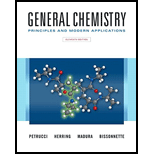
Concept explainers
(a)
Interpretation:
The formula of the product obtained upon dissolution of
Concept introduction:
Nucleophilic substitution reaction
(b)
Interpretation:
The reaction mechanism of the given nucleophilic substitution reaction is to be determined.
Concept introduction:
Nucleophilic substitution reaction
Want to see the full answer?
Check out a sample textbook solution
Chapter 27 Solutions
Generl Chem Looself&mod Mst/et&stdy Crd Pkg, 11/e
- 4. Write the formula and name for the product when cyclopentene reacts with (a) Cl2(b) HBr(c) H2, Pt (d) H2O, H+arrow_forwardDetermine the DOU for the following molecules and suggest a structure for each. C5H7Br2ONarrow_forwardDraw and name the seven aldehydes and ketones with the formula C5H10O. Which are chiral?arrow_forward
- C7H9N has 4 degrees of unsaturation, what are the possible structures?arrow_forwardCompound A(C7H15Br) is not a primary alkyl bromide. It yields a single alkene(compound B) on being heated with sodium ethoxide in ethanol. Hydrogenation of compound B yields 2,4-dimethylpentane. Identify compounds A and B.arrow_forwardWhat is the degree of unsaturation for C6H8? Draw two possible structures.arrow_forward
- a) When (Z)-3-methylhex-3-ene undergoes hydroboration–oxidation, two isomeric products are formed. Give their structures, and label each asymmetric carbon atom as (R) or (S). What is the relationship between these isomers?arrow_forward2-chloropropane is a major product of the reaction of chlorine with propane under ultraviolet light. Write the mechanism for this reaction including the initiation step and the two propagation steps.arrow_forwardWhich alcohols can be prepared as a single product by hydroboration–oxidation of an alkene? Which alcohols can be prepared as a singleproduct by the acid-catalyzed addition of H2O to an alkene?arrow_forward
- Disregarding stereoisomers, draw the structures of all alkenes with molecular formula C5H10. Which ones can exist as cis–trans isomers?arrow_forwardA compound, C5H8, is treated with excess HCl to produce a compound, C5H9Cl. Draw all possible structures for the initial compound.arrow_forwardIdentify the following reactions as addition, elimination, substitution or rearrangementsarrow_forward

 Organic ChemistryChemistryISBN:9781305580350Author:William H. Brown, Brent L. Iverson, Eric Anslyn, Christopher S. FootePublisher:Cengage Learning
Organic ChemistryChemistryISBN:9781305580350Author:William H. Brown, Brent L. Iverson, Eric Anslyn, Christopher S. FootePublisher:Cengage Learning

